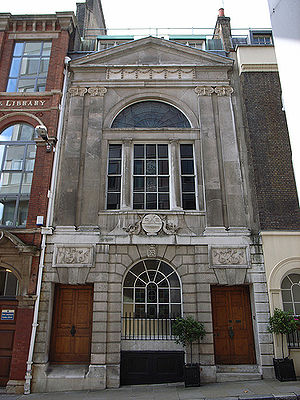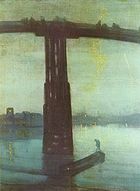
Lightermen
Encyclopedia

Barge
A barge is a flat-bottomed boat, built mainly for river and canal transport of heavy goods. Some barges are not self-propelled and need to be towed by tugboats or pushed by towboats...
s called lighter
Lighter (barge)
A lighter is a type of flat-bottomed barge used to transfer goods and passengers to and from moored ships. Lighters were traditionally unpowered and were moved and steered using long oars called "sweeps," with their motive power provided by water currents...
s in the Port of London.
History
They were one of the most characteristic groups of workers in London's docks during the heyday of the Port of LondonPort of London
The Port of London lies along the banks of the River Thames from London, England to the North Sea. Once the largest port in the world, it is currently the United Kingdom's second largest port, after Grimsby & Immingham...
, but their trade was eventually rendered largely obsolete by changes in shipping technology. They were closely associated with the watermen
Watermen
Watermen are river workers who transfer passengers across and along city centre rivers and estuaries in Britain and its colonies. Most notable are those on the River Thames and River Medway, but other rivers such as the River Tyne and River Dee, Wales also had their watermen who formed guilds in...
, who carried passengers, and in 1700 joined the Company of Watermen to form The Company of Watermen and Lightermen. This is not, strictly speaking, a livery company
Livery Company
The Livery Companies are 108 trade associations in the City of London, almost all of which are known as the "Worshipful Company of" the relevant trade, craft or profession. The medieval Companies originally developed as guilds and were responsible for the regulation of their trades, controlling,...
but a "City Company Without Grant of Livery", formed in 1700 by Act of Parliament. The Guild continues to licence watermen and lightermen working on the River Thames
River Thames
The River Thames flows through southern England. It is the longest river entirely in England and the second longest in the United Kingdom. While it is best known because its lower reaches flow through central London, the river flows alongside several other towns and cities, including Oxford,...
. Watermans' Hall is located at 16 St Mary At Hill, in Billingsgate
Billingsgate
Billingsgate is a small ward in the south-east of the City of London, lying on the north bank of the River Thames between London Bridge and Tower Bridge...
, it dates to 1780 and is the only surviving Georgian
Georgian architecture
Georgian architecture is the name given in most English-speaking countries to the set of architectural styles current between 1720 and 1840. It is eponymous for the first four British monarchs of the House of Hanover—George I of Great Britain, George II of Great Britain, George III of the United...
guild hall.
The construction of the docks was bitterly opposed by the lightermen and other vested interests, but went ahead anyway. However, they did win a major concession: what became known as the "free-water clause", first introduced into the West India Dock
West India Docks
The West India Docks are a series of three docks on the Isle of Dogs in London, the first of which opened in 1802. The docks closed to commercial traffic in 1980 and the Canary Wharf development was built on the site.-History:...
Act of 1799 and subsequently written into the Acts governing all of the other docks. This stated that there was to be no charge for "lighters or craft entering into the docks ... to convey, deliver, discharge or receive ballast or goods to or from on board any ship ... or vessel." This was intended to give lighters and barges the same freedom in docks that they enjoyed on the open river. In practice, however, this proved highly damaging to the dock owners. It allowed ships to be loaded and unloaded overside, using barges and lighters to transfer their goods to and from riverside wharves rather than dock quays, thus bypassing quay dues and dock warehouses. This significantly reduced the docks' income and harmed their finances, while boosting the profits of their riverside competitors. Not surprisingly, the dock owners lobbied vigorously—but unsuccessfully—for the abolition of this damaging privilege.
Operation
The lightermen were a vital component of the Port of London before the enclosed docks were built during the 19th and 20th century. Ships would moor in the middle of the River Thames and transfer their goods aboard lighters. Lightermen would then ride the river's currents—upstream when the tide was coming in, downstream when the tide was out—to transfer the goods to quay-sides. They also transferred goods up and down the river from quays to riverside factories and vice-versa. This was an extremely skilled job, requiring an intimate knowledge of the river's currents and tides. It also demanded a lot of muscle power, as the lighters were unpowered; they relied on the current for motive force and on long oars, or "paddles", for steering.
Intermodal container
An intermodal container is a standardized reusable steel box used for the safe, efficient and secure storage and movement of materials and products within a global containerized intermodal freight transport system...
, which led to the closure of most of London's upriver docks in the 1960s.
Few written accounts of the process of becoming an apprentice now exist, though the best-known is Men of the Tideway by Dick Fagan and Eric Burgess. (Fagan worked as a lighterman for more than forty years). In the book, Fagan mentions the exploitative nature of lighterage and expresses his disdain for what he called a "free-for-all capitalist system".
See also
- The Thames Barge Driving RaceThe Thames Barge Driving RaceThe Thames Barge Driving Race or TOW Barge Driving Race is a river race that was set up in 1975 by a charity called The Transport On Water Association with the backing of Members of Parliament and Members of the House of Lords in the United Kingdom....
- ContainerizationContainerizationContainerization is a system of freight transport based on a range of steel intermodal containers...
- LighteringLighteringLightering is the process of transferring cargo between vessels of different sizes, usually between a barge and a bulker or oil tanker. Lightering is undertaken to reduce a vessel's draft in order to enter port facilities which cannot accept very large ocean-going vessels...
External links
- Watermen's Hall Official Site
- Men of the Tideway by Fagan and Burgess (Chapters 1 & 2 available only)
- Waterman's Hall
- Company of Watermen and Lightermen
- http://www.portcities.org.uk/london/server/show/conMediaFile.1397/A-London-lighterman-c-1910.html
- Thames Lighterman photos
- Lighterman apprentice certificates and licences

